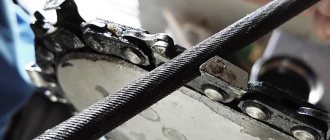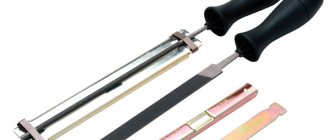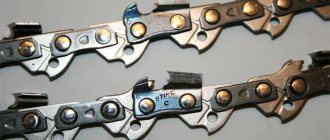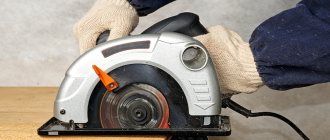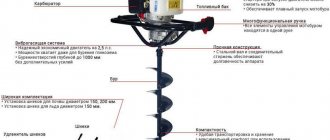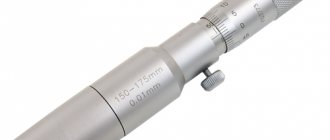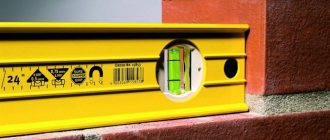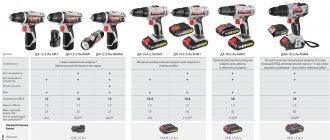Types of chains for chainsaws
Before choosing chains for your chainsaw, you need to consider their varieties. The elements under consideration differ due to the classification of chainsaws, which are household, professional and semi-professional. Before you buy a saw chain, you need to understand the types of saw accessories available.
Types of saw sets
Not every professional knows how to choose the device in question for their instrument. After all, after purchasing a tool, the need to purchase and replace a saw set does not arise earlier than after a few years, provided that the chainsaw is used seasonally. Not only chainsaws have the appropriate technical parameters, but also the saw set. For both a chainsaw and an electric saw, you need to select a chain based on the technical characteristics of the tool. The main parameters of the devices under consideration are:
Eliminating chain slack
With prolonged use, the chain may sag. No need to worry about how to tension the chain on the saw. This is quite easy to do with a special wrench or tension adjustment screw.
The main types of saw chains and their features are described above. Knowing them, it’s quite easy to independently choose the chain saw that is needed in each specific case.
Choosing the right chain allows you to complete the necessary tasks as quickly and efficiently as possible.
Shank thickness - width of drive links
The tail part is the section of the chain that is located in the inner part of the tire. The tail section comes in different thicknesses, so it should be selected depending on the size of the tire groove. The lower the power of the chainsaw, the smaller the thickness of the tail part of the chain is needed. The following thickness dimensions of the tail parts of the chains are distinguished:
- 1.1 mm
- 1.3 mm
- 1.5 mm
- 1.6 mm
- 2 mm
For household chainsaws, devices with a shank size of 1.1-1.3 mm are suitable, and for professional ones, materials with a shank thickness of 1.6 mm are used. Thickness 1.5 mm is used for semi-professional and professional units. The 2mm tail section of the links means that these devices are designed for specialist professional chainsaws that are used in harsh conditions. For electric saws you need to buy chains with a shank size of 1.1 mm.
How to choose a device based on the thickness of the tail section
Length - overall size
The size of the new chain depends on the length of the tire. Typically, tires last 2 times longer than chains, provided that they are made from high-quality materials. To determine the required length of the purchased chain for your tool, you need to measure the tire size. Usually the length is indicated on the side of the tire, but over time, all markings are erased. You can find out the length of the tire by referring to the tool's passport or measuring it with a ruler.
Measuring tire length - how to measure correctly
If you decide to replace the bar and chain with a larger size, then this can be done in exceptional cases when the power of the chainsaw matches. If you install a bar one size larger on a household saw, then it will not cope with the task in terms of engine power. The data sheet for the tool indicates the recommended tires for installation of the appropriate length.
Replacing the saw chain yourself
Companies that produce electric saws do not prohibit replacing the chain yourself; on the contrary, they often include new products with instructions for repairing and replacing individual parts. You should start by purchasing a new chain.
We check the chain for compliance, that is, we study its characteristics: length (depending on the tire), pitch size (relative to the sprockets), thickness of the drive link
One of the common designs of budget saws is with side tension. To change the chain, perform the following steps in turn:
- move the protective shield while releasing the brake;
- use a screwdriver to turn the control tension screw, unscrew the nut, thereby loosening the tension;
- remove the cover;
- separate the bar and chain from the sprocket;
- remove the old chain from the tire and install a new one in its place;
- We perform the steps in reverse order.
We tighten the chain smoothly, without jerking. We finally tighten it after closing the plastic cover using a screw and nut.
There are modern systems for keyless chain tensioning, but many mechanics prefer traditional side tensioning, which is somewhat problematic, but proven and reliable.
Modern models of electric saws have so-called wing nuts for operational chain tension
Thanks to this element, the replacement process is faster - and this is important for large volumes of work. Having released the brake, unscrew the nut and remove the cover
Slightly moving the tire back, remove the old chain, put on a new one - first on the sprocket, then along the entire length. Then we put the sprocket in place and tighten the nut. We turn the tension wheel in the direction indicated on the body and finally tighten the “lamb”.
The last step is to check the chain tension. It should fit snugly against the tire when the brake is released, but rotate under manual pressure. For a more effective check, it is recommended to run the saw at low speeds
You can watch the video for more information about chain tensioning:
Latest posts 4 healthy exotic vegetables that you should try to plant in 2021 3 best fertilizers for cucumbers that will help you get a great harvest 7 flowers that are worth sowing in January to see a beautiful garden in June
Depth of cut - a parameter depending on the tooth profile
The larger the tooth profile (size), the greater the depth of cut in one pass. The higher the cutting depth value, the greater the tool performance value. It is important that the higher the cutting depth of chainsaw chains, the greater the load on the tool’s engine.
Determining cutting depth
The height of the links also affects the strength of the teeth, and the larger they are, the lower the strength index. Standard models of saw sets are available in two tooth heights - 0.635 and 0.762 mm. Products with a smaller profile height are called low-profile, and products with a larger profile are called high-profile. The cutting depth affects the time it takes to cut the wood.
Existing step sizes
Chain pitch is a key parameter that requires special attention when choosing a cutting element for a chainsaw. It is measured in inches and is defined as the gap between the cutting links or the gap between the three rivets of the saw element. The following image clearly illustrates how chain pitch is determined.
Each saw has an individual chain pitch.
It is worth noting that the pro-class tool works with any type of circuit.
Chains with a certain pitch are always intended for units of a certain power, taking into account torque. Reducing the pitch not only reduces the performance of the device, but also reduces the load on the engine. Conversely, with a large step, the productivity of the device increases, but more power is required.
In addition, there is such a thing as the “aggressiveness” of the unit. In this case, we mean ease of control. The larger the step, the more force the teeth “tear” the wood. In addition, due to the large size of the cutting links, the width of the cut also increases, which means that the operator will need to make more effort to hold the device in his hands. Based on the above, it is not worth using a chain with a large pitch on a low-power unit, since this can render the device unusable.
0.325" pitch
This is the minimum step value, but nevertheless the most common. Saw elements with this pitch are usually installed on amateur and semi-professional units that have low power - in the range of 3-3.5 hp. This is enough to easily cut branches, fell thin trees, and carry out minor construction work. The 0.325-inch pitch chain operates smoothly, vibration-free, does not “rip” wood, does not overload the engine or fatigue the operator.
Pitch 0.375 or 3/8
The marking may look like a decimal fraction or an ordinary fraction. There is no difference between these notations: three divided by eight equals 0.375. The common fraction in the marking is intended to eliminate confusion between the numbers 0.375 and 0.325.
For this reason, there are times when it is difficult to find an element with a pitch of 0.375 inches on sale. If so, try looking for the same part marked 3/8.
These chains are installed on more powerful units - those with 4 hp. These saw blades can be used to cut down trees of medium diameter. Chains with a pitch of 3/8 inches are installed on semi-professional chainsaws and pro-class units.
Step 0.404
Saws with this pitch are installed only on professional units with a power of at least 5.5 hp. A saw with a pitch of 0.404 inches can cut down trees of any thickness, and the units for this cutting element have a large torque, which greatly facilitates human work.
It is important to know that the chain pitch always corresponds to the pitch of the sprockets, both driven and driven. It follows from this that if the documentation for the device indicates that it works with a chain with a pitch of 0.404, then you should not put a chain on a chainsaw with a pitch of 3/8. Before installing a chain with a different pitch, it is necessary to purchase a complete kit, including both the bar and both sprockets: drive and driven.
In addition to the above pitch values, there are two more: these are 1⁄4 (0.25) inches and 3⁄4 (0.75) inches. Saws with this pitch are not very popular among both professionals and home craftsmen.
Types of links - design or shape of the link
There are two types of modern saw sets in shape - chipper and chisel. Each type is structurally different, affecting performance parameters and sharpening features.
- Chipper links look like a sickle and have poor performance. Their main advantage is the ease of sharpening with a file. It is precisely due to the ease of sharpening that many sawmills prefer to choose models with chipper or crescent-shaped links.
- Chisel links have teeth shaped like a number "7" with a pointed corner. These teeth on the chain show high performance, but at the same time they are difficult to sharpen with a file.
Chisel and chipper link types - please note
Sequence of links - distance of cutting teeth
There are three types of sequence of links:
- Standard - when the cutting teeth are located on each link
- With semi-skip - when the teeth are arranged in the order “one through two”
- With a skip - the cutting teeth are located through one chain link
Models with a pass are common, as they do not load the engine of the tool. Standard models are used only on professional units, and semi-pass chains can be installed on household and electric saws to relieve the load on the motor.
Location of links
Cutting link material
Basically, 2 main types of steel are used in the manufacture of cutting teeth, which are one of the main characteristics of chains:
- Alloy or chromium-nickel steel, used when cutting soft wood;
- Steel reinforced with hard-melting tips is used for hard wood or heavily contaminated and frozen wood.
Types of sawing - transverse or longitudinal method
Chainsaws with chains for cross-cutting wood are in demand. Longitudinal sawing is needed in rare cases, but if you need to use such a headset, you need to take into account that such materials are more expensive than conventional ones. The difference between the methods under consideration is that for longitudinal chains the sharpening angle is 5-10 degrees. For transverse models, the sharpening angle corresponds to a value of 25-30 degrees. You can clarify this information on the design of the saw set.
Longitudinal and cross cutting
Types of chains for chainsaws
Those who have dealt with sawing wood know that it can be sawed either along the grain or across it. Based on this, different types of chains for chainsaws are produced: for transverse or longitudinal cutting of wood. In both cases, the difference in material resistance will be significantly different. For longitudinal sawing, the teeth are sharpened at an angle from 5 to 15°. Cross cutting requires sharpening the tool at an angle of 25-35°. The figure below shows how the tooth sharpening angle is determined.
What type of saw element is can be found out from the markings on it; in addition, the sharpening angle is determined visually.
Chains for longitudinal sawing are used extremely rarely, because it is much easier to unravel the workpiece on a circular saw. Due to low demand, manufacturers of this tool do not particularly improve it, and it is quite difficult to find a chain for rip sawing on sale. Most chainsaw buyers choose a tool with a cross-cut type, and it is the most popular among both professionals and home craftsmen. But, before choosing a chain for a chainsaw, you should study the main parameters that affect the performance and quality of the tool.
Materials - what chains are made of
This is one of the most important parameters on which the duration of operation depends. The cutting teeth are made of alloy steel and are not subjected to heat treatment. If you come across a device whose teeth are subject to heat treatment, this means that the product is not intended for sharpening. Typically, these devices last a long time, but if the teeth become dull, they require immediate replacement.
The headset is produced with teeth coated with diamond or pobedit. The cost of the devices is several times more expensive, and it is better to buy them when you need to work with hard and frozen types of wood.
The best brands of chainsaw chains
Based on reviews from the owners of these units, a rating of chains for chainsaws has been compiled. Below are the manufacturers that make the best chainsaw chains.
- Stihl is a very famous Swiss brand that produces saw chains made of high-strength chromium-nickel steel. They do not stretch when heated like regular ones. This is achieved through the use of a special hot riveting method in production. In addition, this manufacturer has patented a lubrication method - “grooves”, which are supplied to all drive links.
- The company does not design chains, but manufactures them using the best patented technologies. Thanks to this, high quality products are achieved. The company also provides a wide range of services to customers, providing warranty service for its products. In addition, the company's clients have the opportunity to purchase original spare parts for mechanisms.
- Oregon is a division of Blount Inc. The company is considered one of the best among companies producing saw elements for chainsaws. Oregon also produces various accessories and spare parts for instruments of other well-known brands. The sawing elements of chainsaws are made of a special patented alloy, and a chromium alloy is applied to the teeth. To facilitate the sharpening process, marks are placed on the teeth indicating at what angle this operation must be performed. In addition, the chains have a system that reduces vibration and an original design, thanks to which the lubricant is distributed evenly.
- Carlton is a company from America. All chain elements from this manufacturer have increased hardness because they undergo shot blasting at the manufacturing stage. The cutting links have a long edge, making it possible to perform a large number of sharpenings.
- Windsor. The company has patented a super-strong alloy that is highly heat-resistant and does not stretch. Windsor saw elements use stamped links and sealed rivets to ensure high reliability.
- The chain is made of alloy steel with chrome-plated teeth. The latter are sharpened in a special way, and a hypoid lubricant is applied to the chain, facilitating the sawing process. The company also uses the shot-peening method in the manufacture of chains, which increases the strength of the links.
If you need to buy a new chain - what to look for
To choose a chain for your chainsaw, you need to know the pitch, shank thickness, length, cutting depth, type of links, as well as the type of sawing, material and sequence of teeth. All these criteria have been discussed above. To avoid having to trust sellers, you need to understand each criterion and choose the right values for yourself.
Saw accessories
You can learn from specialists how to choose the right saw set. At the same time, it is not necessary to look for them, since the material contains a video that tells in detail about the correct choice of chain. The choice is also influenced by price, which directly characterizes quality. The higher the price, the better the quality, but it doesn’t always make sense to purchase expensive devices. Saw sets are produced by various manufacturers, both branded (Shtil, Makita, Husqvarna) and little-known ones, including Chinese.
If you want to buy a good device that will serve you for at least 3 seasons, then it is better to buy expensive models. Cheap models are only worth using them on household units. After purchasing a new headset, you need to tighten the chain on the saw.
